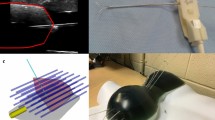Abstract
Purpose
Ultrasound (US) guided procedures are frequently performed for diagnosis and treatment of many diseases. However, there are safety and procedure duration limitations in US-guided interventions due to poor image quality and inadequate visibility of medical instruments in the field of view. To address this issue, we propose an interventional imaging system based on a mobile electromagnetic (EM) field generator (FG) attached to a US probe.
Methods
A standard US probe was integrated with an EM FG to allow combined movement of the FG with real-time imaging to achieve (1) increased tracking accuracy for medical instruments are located near the center of the tracking volume, (2) increased robustness because the FG is distant to large metallic objects, and (3) reduced setup complexity since time-consuming placement of the FG is not required. The new integrated US-FG imaging system was evaluated by assessing tracking and calibration accuracy in a clinical setting. To demonstrate clinical applicability, the prototype US-EMFG probe was tested in needle puncture procedures.
Results
The mobile EMFG attached to a US probe yielded sub-millimeter tracking accuracy despite the presence of metal close to the FG. Calibration errors were in the range of 1–2 mm. In an initial phantom study on US-guided needle punctures, targeting errors of about 3 mm were achieved.
Conclusion
A combined US-EMFG probe is feasible and effective for tracking medical instruments relative to US images with high accuracy and robustness while keeping hardware complexity low.






Similar content being viewed by others
Notes
A preliminary version of this paper, focusing on the aspect of needle navigation, was presented at the IPCAI conference in 2013 which resulted in the invitation to this special issue [11].
References
Franz AM, März K, Hummel J, Birkfellner W, Bendl R, Delorme S, Schlemmer HP, Meinzer HP, Maier-Hein L (2012) Electromagnetic tracking for US-guided interventions: standardized assessment of a new compact field generator. Int J Comput Assist Radiol Surg 7(6):813–818
Franz AM, März K, Seitel A, Kenngott HG, Wagner M, Preukschas A, Meinzer HP, Wolf I, Maier-Hein L (2013) Combined modality for ultrasound imaging and electromagnetic tracking. Biomed Tech (Berl) [Epub ahead of print]
Franz AM, Seitel A, Servatius M, Zöllner C, Gergel I, Wegner I, Neuhaus J, Zelzer S, Nolden M, Gaa J, Mercea P, Yung K, Sommer CM, Radeleff BA, Schlemmer HP, Kauczor HU, Meinzer HP, Maier-Hein L (2012) Simplified development of image-guided therapy software with MITK-IGT. In: SPIE Medical Imaging 2012: Image-Guided Procedures, Robotic Interventions, and Modeling, vol 8316, p 83162J (8 pages)
Franz AM, Servatius M, Seitel A, Kauczor HU, Meinzer HP, Maier-Hein L (2008) Navigated targeting of liver lesions: pitfalls of electromagnetic tracking. Biomed Eng 57(1):897–900
Hummel JB, Bax MR, Figl ML, Kang Y, Calvin Maurer J, Birkfellner WW, Bergmann H, Shahidi R (2005) Design and application of an assessment protocol for electromagnetic tracking systems. Med Phys 32(7):2371–2379
Khati NJ, Gorodenker J, Hill M (2011) Ultrasound-guided biopsies of the abdomen. Ultrasound Q 27(4):255–268
Kliewer MA, Sheafor DH, Paulson EK, Helsper RS, Hertzberg BS, Nelson RC (1999) Percutaneous liver biopsy: a cost-benefit analysis comparing sonographic and CT guidance. Am J Roentgenol 173(5):1199–1202
Maier-Hein L, Franz AM, Birkfellner W, Hummel J, Gergel I, Wegner I, Meinzer HP (2012) Standardized assessment of new electromagnetic field generators in an interventional radiology setting. Med Phys 39(6):3424–3434
Maier-Hein L, Tekbas A, Seitel A, Pianka F, Müller SA, Satzl S, Schawo S, Radeleff B, Tetzlaff R, Franz AM, Müller-Stich BP, Wolf I, Kauczor HU, Schmied BM, Meinzer HP (2008) In vivo accuracy assessment of a needle-based navigation system for CT-guided radiofrequency ablation of the liver. Med Phys 35(12):5385–5396
März K, Franz AM, Seitel A, Winterstein A, Bendl R, Zelzer S, Nolden M, Meinzer HP, Maier-Hein L (2013) MITK-US: Real-time ultrasound support within MITK. Int J Comput Assist Radiol Surg, BVM Special Issue [Epub ahead of print]
März K, Franz AM, Stieltjes B, Iszatt J, Seitel A, Radeleff BA, Meinzer HP, Maier-Hein L (2013) Mobile EM field generator for ultrasound guided navigated needle insertions. In: Information Processing in Computer-Assisted Interventions 4th International Conference, IPCAI 2013, pp 71–80
Mercier L, Lang T, Lindseth F, Collins D (2005) A review of calibration techniques for freehand 3-d ultrasound systems. Ultrasound Med Biol 31(4):449–471
Muratore DM, Galloway RL (2001) Beam calibration without a phantom for creating a 3-d freehand ultrasound system. Ultrasound Med Biol 27(11):1557–1566
Nolden M, Zelzer S, Seitel A, Wald D, Mller M, Franz A, Maleike D, Fangerau M, Baumhauer M, Maier-Hein L, Maier-Hein K, Meinzer HP, Wolf I (2013) The medical imaging interaction toolkit: challenges and advances. Int J Comput Assist Radiol Surg 8(4):607–620
Peters T, Cleary K (eds) (2008) Image-guided interventions: technology and applications. Springer, Berlin
Poulin F, Amiot L (2002) Interference during the use of an EM tracking system under OR conditions. J Biomech 35:733–737
Seitel A, Engel M, Sommer CM, Radeleff BA, Essert-Villard C, Baegert C, Fangerau M, Fritzsche KH, Yung K, Meinzer HP, Maier-Hein L (2011) Computer-assisted trajectory planning for percutaneous needle insertions. Med Phys 38(6):3246–3259
Sindram D, Swan RZ, Lau KN, McKillop IH, Iannitti DA, Martinie JB (2011) Real-time three-dimensional guided ultrasound targeting system for microwave ablation of liver tumours: a human pilot study. HPB 13(3):185–191
Yaniv Z, Wilson E, Lindisch D, Cleary K (2009) Electromagnetic tracking in the clinical environment. Med Phys 36(3):876–892
Acknowledgments
This work was carried out with the support of the German Research Foundation (DFG) as part of project A02, SFB/TRR 125 Cognition-Guided Surgery. Furthermore, it was supported by the Intramural Funding Program of the German Cancer Research Center (DKFZ), Grant for Young Investigators. The Authors would like to thank Sigmar Fröhlich, Gina Jackson, Stefan Kirsch and Nina Stecker (NDI Europe GmbH) for providing additional needles for the experiment.
Conflict of interest
None.
Author information
Authors and Affiliations
Corresponding author
Rights and permissions
About this article
Cite this article
März, K., Franz, A.M., Seitel, A. et al. Interventional real-time ultrasound imaging with an integrated electromagnetic field generator. Int J CARS 9, 759–768 (2014). https://doi.org/10.1007/s11548-014-0990-3
Received:
Accepted:
Published:
Issue Date:
DOI: https://doi.org/10.1007/s11548-014-0990-3




